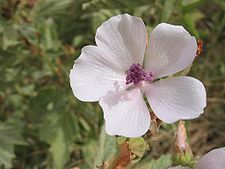- Althaea officinalis
-
Althaea officinalis 
Scientific classification Kingdom: Plantae (unranked): Angiosperms (unranked): Eudicots (unranked): Rosids Order: Malvales Family: Malvaceae Genus: Althaea Species: A. officinalis Binomial name Althaea officinalis
L.Althaea officinalis (Marshmallow, Marsh Mallow, Marshmellow, or Common Marshmallow) is a species indigenous to Africa, which is used as a medicinal plant and ornamental plant. A confection made from the root since ancient Egyptian time evolved into today's marshmallow treat.
Contents
Description
The stems, which die down in the autumn, are erect, 3 to 4 feet (1.2 m) high, simple, or putting out only a few lateral branches. The leaves, shortly petioled, are roundish, ovate-cordate, 2 to 3 inches (76 mm) long, and about 1 1/4 inch broad, entire or three to five lobed, irregularly toothed at the margin, and thick. They are soft and velvety on both sides, due to a dense covering of stellate hairs. The flowers are shaped like those of the common Mallow, but are smaller and of a pale colour, and are either axillary, or in panicles, more often the latter.
The stamens are united into a tube, the anthers, kidney-shaped and one-celled. The flowers are in bloom during August and September, and are followed, as in other species of this order, by the flat, round fruit which are popularly called 'cheeses.'
The common Mallow is frequently called by country people 'Marsh Mallow,' but the true Marsh Mallow is distinguished from all the other Mallows growing in Great Britain, by the numerous divisions of the outer calyx (six to nine cleft), by the hoary down which thickly clothes the stems and foliage, and by the numerous panicles of blush-coloured flowers, paler than the Common Mallow. The roots are perennial, thick, long and tapering, very tough and pliant, whitish yellow outside, white and fibrous within. The whole plant, particularly the root, abounds with a mild mucilage, which is emollient to a much greater degree than the common Mallow. The generic name, Althaea, is derived from the Greek altho (to cure), from its healing properties. The name of the family, Malvaceae, is derived from the Greek malake (soft), from the special qualities of the Mallows in softening and healing.
Most of the Mallows have been used as food, and are mentioned by early classic writers with this connection. Mallow was an esculent vegetable among the Romans; a dish of Marsh Mallow was one of their delicacies. Prosper Alpinus stated in 1592 that a plant of the Mallow kind was eaten by the Egyptians. Many of the poorer inhabitants of Syria subsist for weeks on herbs, of which Marsh Mallow is one of the most common. When boiled first and fried with onions and butter, the roots are said to form a palatable dish, and in times of scarcity consequent upon the failure of the crops, this plant, which fortunately grows there in great abundance, is much collected for food.
Traditional uses
The leaves, flowers and the root of A. officinalis (marshmallow) all have medicinal properties. These are reflected in the name of the genus, which comes from the Greek althainein, meaning "to heal".[1] In traditional Chinese medicine, Althaea officinalis is known as 藥蜀葵 (pinyin: yàoshǔkuí). It increases the flow of breast milk and soothes the bronchial tubes.[2][unreliable source?]
Marshmallow is traditionally used as a treatment for the irritation of mucus membranes, including use as a gargle for mouth and throat ulcers, and gastric ulcers.[3] A study on rats concluded that an extract from the flowers has potential benefits for hyperlipidemia, gastric ulcers and platelet aggregation.[4]
The root extract (halawa extract) is sometimes used as flavouring in the making of a middle eastern snack called halva. The flowers and young leaves can be eaten, and are often added to salads or are boiled and fried.
The root has been used since the Middle Ages in the treatment of sore throat.[5] The later French version of the recipe, called pâté de guimauve (or "guimauve" for short), included an eggwhite meringue and was often flavored with rose water. Pâté de guimauve more closely resembles contemporary commercially available marshmallows, which no longer contain any actual marshmallow.
Chemistry
Chemical constituents include altheahexacosanyl lactone (n-hexacos-2-enyl-1,5-olide), 2β-hydroxycalamene (altheacalamene) and altheacoumarin glucoside (5,6-dihydroxycoumarin-5-dodecanoate-6β-D-glucopyranoside), along with the known phytoconstituents lauric acid, β-sitosterol and lanosterol.[6]
See also
References
- ^ Gualtiero Simonetti (1990). Stanley Schuler. ed. Simon & Schuster's Guide to Herbs and Spices. Simon & Schuster, Inc. ISBN 0-671-73489-X.
- ^ "Marshmallow Remedies | Gaia Garden Herbals". Gaiagarden.com. http://www.gaiagarden.com/products/marshmallow/. Retrieved 2009-01-03.
- ^ John S. Williamson & Christy M. Wyandt 1997. Herbal therapies: The facts and the fiction. Drug topics
- ^ Hage-Sleiman, R; Mroueh, M; Daher, CF (2011). "Pharmacological evaluation of aqueous extract of Althaea officinalis flower grown in Lebanon". Pharmaceutical biology 49 (3): 327–33. doi:10.3109/13880209.2010.516754. PMID 21281251.
- ^ Petkewich, Rachel (2006). "What's that stuff? Marshmallow". Chemical & Engineering News 84 (16): 41. doi:10.1021/cen-v084n011.p041. http://pubs.acs.org/cen/whatstuff/84/8416marshmallows.html. Retrieved 2008-02-10.
- ^ Rani, S.; Khan, S.A.; Ali, M. (2010). "Phytochemical investigation of the seeds of Althea officinalis L". Natural Product Research 24 (14): 1358–1364. doi:10.1080/14786411003650777. PMID 20803381.
External links
Categories:- Malveae
- Medicinal plants
- Demulcents
Wikimedia Foundation. 2010.

